CTP Episode of the Day - 08.28.06
Today's Cherished Episode: Tithonus (6x09)
Original Air Date: January 24, 1999
Written By: Vince Gilligan
Directed By: Michael W. Watkins
Separated from Mulder and teamed with another FBI agent, Scully pursues a crime photographer with an uncanny ability to predict death -- or perhaps, to cause it.
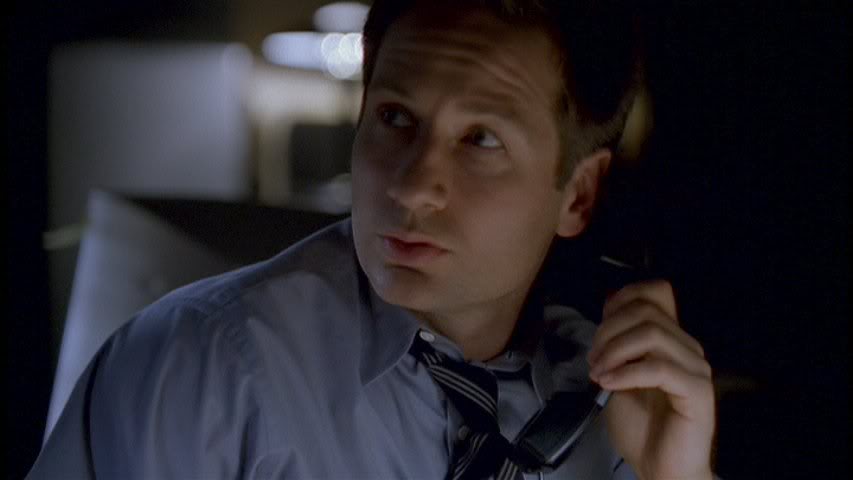
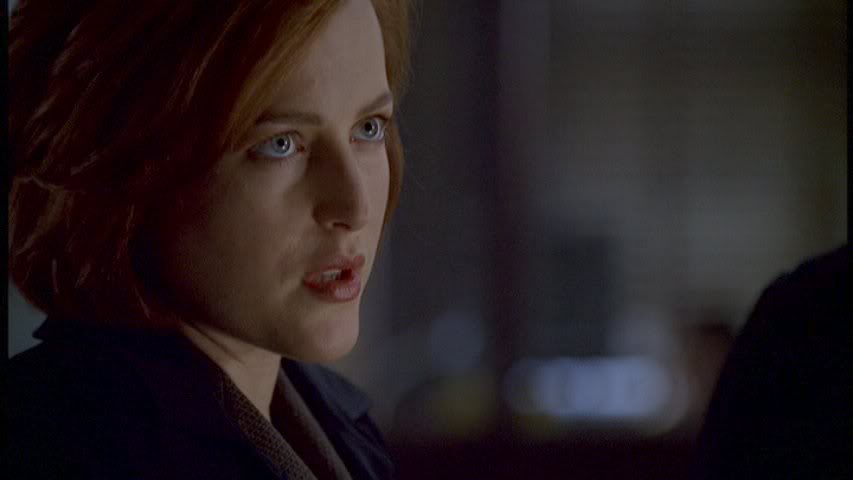
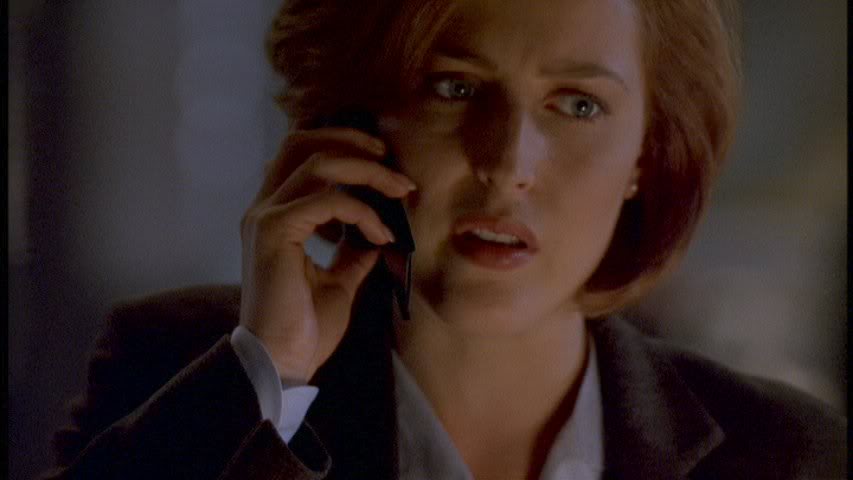
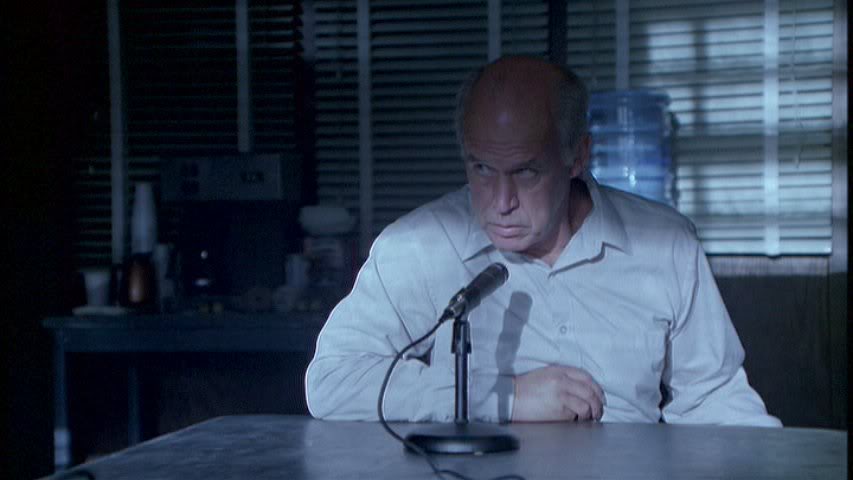
Ritter: You know, Kersh warned me about you.
Scully: He did?
Ritter: Yeah, you and your partner. God knows his reputation precedes him, so I guess I should have seen this coming. You muck up my case, and Kersh'll hear about it. Are we clear, Dana?
Scully: Scully. And we're done with this conversation.
Some "Tithonus" Tidbits & Musings:
-- This moody, darkly gripping drama is based on three nuggets of real-life history:
-- (1) Arthur Fellig (1899 - 1968), better known as Weegee, was a Ukranian immigrant who became one of America's most famous photographers. Prowling the nighttime streets of New York City in a bettered Chevy coupe equipped with a police radio, Weegee supplied the tabloid newspapers of the 1930s and 1940s with remorselessly flashlit photographs of the blood-covered victims of gangland rubouts, traffic accidents, and domestic altercations. He also captured thousands of revealing glimpses of the daily lives of New Yorkers rich and poor. Weegee's work -- collected avidly by museums and individuals alike -- received nationwide exposure via his 1945 book Naked City. A contemporary admirer was X-Files producer John Shiban, who in 1998 lent his copy of a newer Weegee biography/compilation to his friend and coworker, co-executive producer Vince Gilligan.
-- (2) The ancient Greek myth of Tithonus, son of the king of Troy. He was a particular favorite of Eros, goddess of the Dawn, who persuaded Zeus to grant her new boyfriend immortality -- but somehow forgot to include eternal youth in the package. Eventually Tithonus turned white-haired and feeble. Eros lost all interest in him, and he was doomed to watch the sunrise every morning and pray desperately for death. "Tennyson wrote a poem, 'Tithonus,' that's a favorite of my girlfriend Holly Rice," said Vince. "She introduced me to the character."
-- (3) The New York City yellow fever epidemic of the early nineteenth century. Victims were indeed wrapped in yellow sheets and buried in shallow graves in what is now Washington Square Park in New York's Greenwich Village. The park is just a block or two from New York University, where Vince Gilligan attended film school. "The NYU guy leading me through orientation told me the story," said Gillian, "and I never forgot it."
-- Fueled by these prepackaged elements, the basic plotline took shape in a quick jumble of storyboarding and story meetings. "For years we'd been talking about doing a story about immortality," said Frank Spotnitz. "But the problem was it's very hard to make immortality scary. After all, most people think that not dying is a good thing. When we figured out that the Weegee-like figure was trying to photograph death so he could die himself, that solved that problem nicely."
-- Added to the mix were several X-Files specific fillips including the Mulder-Scully separation, which exacerbated the tension created by their probationary status established in "The Beginning" (and gave David Duchovny a relatively "light" week workwise); the customary conflict between Mulder's open-mindedness and intuition and Scully's belief in scientific detection; and references to Scully's own miraculous escape from death from cancer during Season 4.
-- "Also," said Spotnitz, "we came up with the idea of making 'Tithonus' sort of a bookend to 'Clyde Bruckman's Final Repose,' in which Bruckman told Scully that she wouldn't die. Here we could kind of answer that and it was very satisfying."
-- The name "Alfred Fellig" is a combination of the real last name of Weegee and the first name of another famous photographer whom Vince Gilligan admired: Alfred Stieglitz (1864 - 1946), an artist, writer, and gallery owner who produced and championed some of the best American photography of the early twentieth century.
-- The scene in which the streetwalker was run over by a garbage truck was filmed at night directly in front of the executive office building at Twentieth Century Fox Studios.
-- Some of the other New York scenes were filmed on sets borrowed from NYPD Blue, located on the other side of the Fox lot from the X-Files sound stages.
-- Vince Gilligan saluted his girlfriend Holly Rice in "Tithonus" by making one of Fellig's aliases "L.H. Rice" -- and on one press pass application giving him the same birthday, April 4, as Holly's.
-- Henry Strand is named for Paul Strand, who was a New York City photographer in the early 1900s. He went through a period of photographing his subjects without their knowledge in an attempt to extract a "quality of being" from them. At the time this act was quite controversial.
-- Louis Brady may have been named for Mathew Brady, a photographer who covered the Civil War era when photography was still relatively new. He was an accomplished portrait photographer in his time. His subjects included Abraham Lincoln, Edgar Allen Poe, Frederick Douglas, and Susan B. Anthony. He was most famous as a war correspondent who collected images on the Civil War battlefields.
-- Oopsie #1! When Kersh is perusing Scully's personnel file, it lists her address as "Annapolis." The FBI needs to update its personnel records.
-- Oopsie #2! During the interview with Fellig, Agent Ritter gave the date as January 4th. The episode started the day before -- which means Mulder, Scully, and a whole lot of other people were workin' on the weekend. January 3, 1999, was a Sunday.
-- Oopsie #3! The file on Louis Brady said "Felon wanted by the FBI" in 1929, but the FBI wasn't called the FBI until 1935; until then, it was just the "Bureau of Investigation."
-- "Hi. My name is Fox Mulder. We used to sit next to each other at the FBI." It made me smile too, just like Scully.
-- According to Scully herself, it's around 3 a.m. when she handcuffs the man who hassles the streetwalker; but the time stamp on the next scene where she's processing him at the police station said "8 a.m." What was she doing all that time?
-- Quite welcome as well was the fact that "Tithonus" was primarily a character-driven hour, sans elaborate sets and expensive locations, and would be relatively easy on the show's ever-stressed budget. Which didn't, of course, mean any kind of vacation at all for many of the cast and crew members involved.
-- Casting Director Rick Millikan had some tense moments after asking actor Geoffrey Lewis to audition for the crucial role of Alfred Fennig. "But he loved the show and loved the part, so he agreed to come in, thank goodness."
-- Property Master Tom Day recalled that "Tithonus" was the only time during the whole season that he saw a script in its first rough draft. "Somebody in the production office gave me a heads-up call several weeks before I would have normally even begun thinking about that episode. He said, 'Tommy, you gotta see this. You are huge in this show.' And he was right. And to their credit, the producers realized this, and let me hire the extra people I needed."
-- Traditionally, a TV series or movie props department is responsible for all the original photographs and documents seen onscreen. In the case of "Tithonus," that meant all of the pictures taken by and of the immortal photographer Alfred Fellig in his nearly century-long career -- as well as all the 'decades' worth of press passes he'd held and press pass applications he'd filled out.
-- Said Day, "We had to think about this very carefully and figure that whatever city commission was involved would for one reason or another come along and reformat the entire document every few years. We had to research the popular government typefaces and printing technologies of the time, make our best estimate as to when Fellig's mug shot would change from black-and-white to color, and properly yellow each document according to its supposed age."
-- Working closely with the hair and makeup departments, Day and his photographers painstakingly changed actor Geoffrey Lewis's appearance for each specific head shot. Fellig's crime scene photographs -- each one a freeze-framed movie scene in miniature, utilizing actors, costumes, scenery, lighting, makeup, etc. -- was shot using cameras, films, and printing techniques appropriate to the era it was supposedly taken.
-- "And then," said Day, "we had to come up with all the cameras that Fellig actually used, rig them to flash without making sound during filming, make rubber dummies of them for the stunt scenes, and get extra lenses so the special effects guy could drill them and fill them with blood for the shooting scene. It was a great challenge. But it was a huge, huge mountain of work."
-- Also deeply involved in what he called "a killer episode" was set decorator Tim Stepeck, who had the job of filling Alfred Fellig's claustrophobic darkroom with a century's worth of cameras, developers, miscellaneous photographic equipment, and photographs. "There was just no way we could have gotten that stuff through the normal channels from manufacturers," he said.
-- Instead, Stepeck had his boss Corey Kaplan -- a much exhibited photographer as well as The X-Files's production designer -- call in a favor. Kaplan had taught at the University of California at Riverside's Museum of Photography -- possessor of a ten thousand item collection of vintage and antique cameras and photographic equipment. "I think they emptied out that whole museum just for us," marveled Stepeck -- who said that inventorying, guarding, and returning all that irreplaceable equipment cost him a few nights of good sleep.
-- Stepeck added, "The old photographs -- boxes and boxes and boxes of them -- we got from Corbis [the online photographic agency founded by Bill Gates]. We probably ended up using about 150, hanging them on Fellig's darkroom clothesline and all around his studio. We're still trying to figure out how much money we owe."
-- Budgeted more carefully were the dozens of stab wounds -- constructed in precisely graduated sizes to chronicle the process of Alfred Fellig's miraculous healing -- applied to Geoffrey Lewis's body by makeup department head Cheri Montesanto-Medcalf.
-- Set decorator Tim Stepeck has a master's degree in landscape architecture, and considerable experience as a truck driver, which was his entry-level job in the TV-movie business. He had also worked in various capacities as an art director, production designer, and set decorator on various TV movies, feature films -- including Stephen King's Night Flier -- and the TV series American Gothic and Dawson's Creek.
-- Undoubtedly, the biggest line item for visual effects producer Bill Millar was the postproduction transformation into black-and-white instead of color of the individuals, including Scully, whom Fellig sees as doomed. "We used a technique very similar to the one used to wreck all those old movies by colorizing them," said Millar. "In fact, it's basically the same, only in reverse."
-- Millar explained that the painstaking procedure of decolorization involves outlining the portion of the digitized color image you want to turn into black-and-white, selecting a few key frames to set a "histogram" of the tones and shades desired; then letting loose a complicated computer program to complete the job.
-- Millar, who first used this method on an episode of the short-lived NBC series, Nightmare Cafe in 1992, noted that the hit movie Pleasantville, released within a week or two of the night "Tithonus" first aired, was much praised for its innovative use of decolorization, while its employment on "Tithonus" passed virtually without notice. "Interesting, don't you think?" Millar said wryly.
-- The Season 6 DVDs include three deleted scenes from "Tithonus": (1) a scene where the man who eventually has the heart attack confronts Fellig as to why Fellig is following him. (2) A scene where Scully and Ritter review autopsy results via computer and then decide to go to New York (right before the scene where Mulder is looking at the exact same photos). (3) A scene where Fellig takes a bath after he is stabbed and we see the bloody wounds on his back.
-- Geoffrey Lewis (Alfred Fennig) had a long acting career, equally successful in TV and films. He had a long association with Clint Eastwood, appearing in the films High Plains Drifter, Thunderbolt and Lightfoot, Every Which Way But Loose, Bronco Billy, Any Which Way You Can, Pink Cadillac, and Midnight in the Garden of Good and Evil. He is the father of 10 children, several of whom are actors; his most famous offspring is actress Juliette Lewis who costarred in Kalifornia with David Duchovny.
-- Vince Gilligan noted that Geoffrey Lewis was one of the rare actors to contact him and discuss the finer points of his character before shooting started. "We even stayed in touch for a while after the episode was finished," Gilligan said. "He was a very interesting, talented man. And a nice guy, too."
-- Richard Ruccolo (Peyton Ritter) was probably best known for his role on the sitcom Two Guys, a Girl and a Pizza Place in which he played Pete Dunville. His male costar on the series, Ryan Reynolds (who played Berg) also did a guest gig on The X-Files, in Season 3's "Syzygy" (he played Jay "Boom" DeBoom who met an untimely end in the teaser).
-- Hard to Believe -- Absolutely no retreads in this one.
-- Co-executive producer Michael Watkins, for whom "Tithonus" was the second X-Files he directed (the first was "Dreamland II"), also had a few qualms -- albeit less specific ones -- about how "Tithonus" turned out. "It's rare when you get a piece of work that's written so perfectly," he said. "I wish I could have done an equally perfect job directing it, that's all."
-- All of the above *and* a sweet little secret handshake. How could you want anything more?
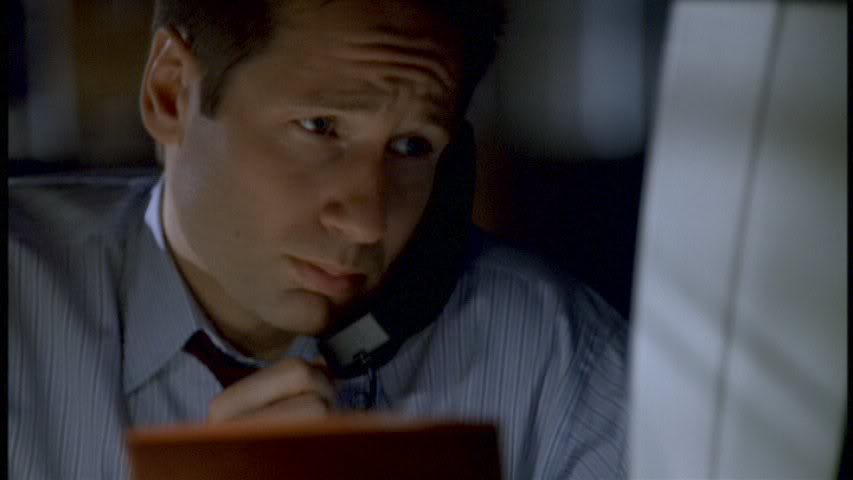

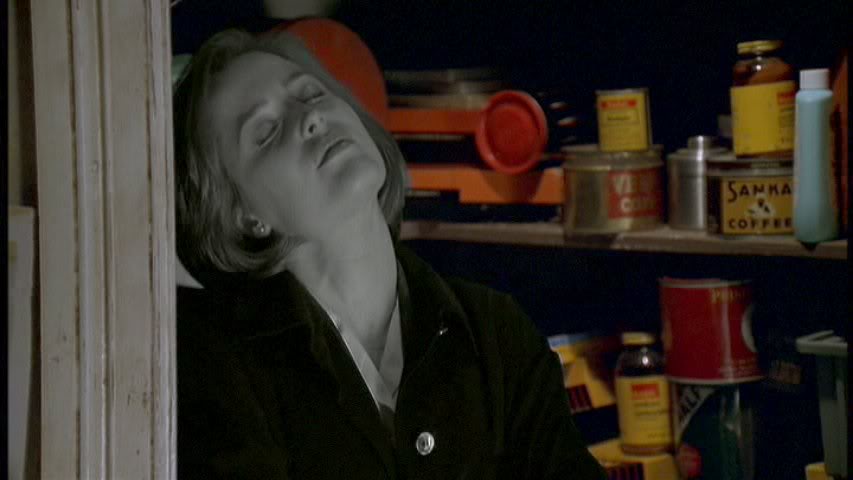

(Thanks to chrisnu for today's episode pics.)
Please share your first impressions, favorite (or cringe-worthy) moments, classic lines, favorite fanfic, nagging questions, repeated viewing observations, etc., as today we celebrate "Tithonus"!
Polly